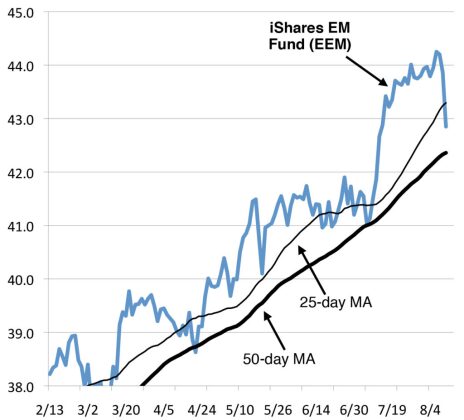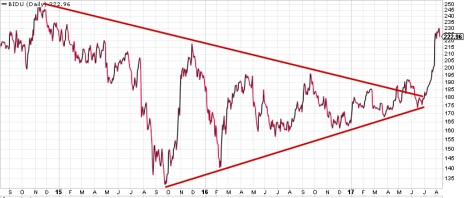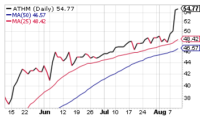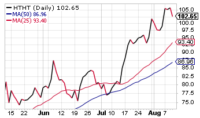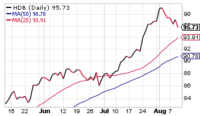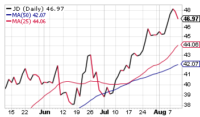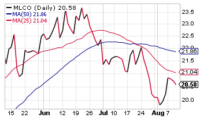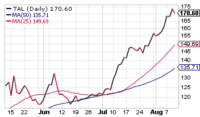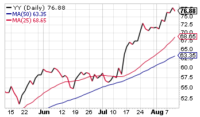Markets sold off slightly on Wednesday, but really got into it on Thursday, with the iShares MSCI ETF falling a full 2%. Despite the blood-letting, the Cabot Emerging Markets Timer is still flashing a green light, indicating that the medium-term trend of the market is still up.
Cabot Emerging Markets Investor 639
[premium_html_toc post_id="137288"]
Cabot Emerging Markets Timer
The Emerging Markets Timer is our disciplined method for staying on the right side of the emerging markets. The Timer is bullish when the index is above the lower of its two moving averages and that moving average is trending up.
Our Emerging Markets Timer remains firmly bullish, as the sector has given up little ground during the market’s recent wobbles. The iShares EM Fund (EEM) is still perched above even its short-term 25-day moving average, and while it’s hit some resistance near 44 during the past two weeks, the action is normal given the prior run-up.
All told, the intermediate-term trend of emerging market stocks is still pointed up, so we’re keeping our bullish hat on. Of course, earnings season will have a big say in the fate of most individual stocks, but with the overall trend up, we’re sticking with a heavily invested stance.
Progress in India
China and India are both huge, rapidly modernizing countries with ancient civilizations and enormous national pride.
Since I took over as Chief Analyst of Cabot Emerging Markets Investor (13 years ago), China has been powering ahead with its industrialization, computerization and digitalization process, achieving in a couple of decades what took Western nations a couple of centuries. And all this has happened under the firm leadership of the Communist Party.
India, meanwhile, with about the same population, hasn’t kept pace. Western analysts have always seen India’s electoral democracy as a potential advantage, but that hasn’t really played out. The legendary Indian bureaucracy, deeply entrenched in the thick layers of national, state and local government, has proven to be a formidable roadblock to state-sponsored projects, including both physical and information infrastructure. (By comparison, China’s all-powerful Communist Party has almost total control over which projects get approved, financed and built, and this has sped development enormously.)
But things may be changing. Narendra Modi, the business-friendly prime minister who came to power in 2014 with a legislative majority that was supposed to pave the way for his programs, has finally delivered a couple of significant wins that will have long-term benefits for the Indian economy.
The first reform was the 2016 withdrawal from circulation of all existing ?500 and ?1000 notes, a move designed to flush cash out of the shadow economy, where huge amounts of undeclared (and untaxed) “black money” was stored. The move, announced suddenly on November 8, 2016, caused significant chaos, but was considered a success despite the protests and inconvenience. (This wasn’t the first time such a move was made; the government demonetized bank notes in 1946 and again in 1978.)
Those holding the old notes had a certain amount of time to bring them in, pay taxes on them and receive new notes in exchange.
Was the move a success? Opinions vary, including the negative effects the program had on the poor, rural households and honest taxpayers. Whatever its success in combating black money, it was a bold attempt in a country that hasn’t seen many bold national actions.
The more recent move was the July 1 implementation of the national Goods and Services Tax (GST), a single tax on goods and services that will do away with the plethora of different taxes imposed by the central government, state governments and inter-state and local authorities.
This new standardized tax regime is expected to create a truly national market in India, which will eventually strengthen an already healthy economy.
The new GST isn’t a blockbuster move, but the Indian economy doesn’t need huge changes. What it needs is a gradual series of changes that will reduce the drag caused by overregulation and bureaucracy. And that appears to be what’s happening.
And on a completely different topic, I should note that the war of words between the U.S. and North Korea, while unsettling, isn’t having a huge effect on markets. The Powershares Emerging Market ETF (EEM) was down about 1% on Wednesday after President Trump’s warnings about the consequences of aggressive action by North Korea and Kim Jong Un’s explicit threat to attack Guam.
As always, the market isn’t responding to the seriousness of the possible consequences of actual conflict but to the probability of that conflict actually occurring. And if the market is correct, that probability is pretty low.
Featured Stock
Finally!
Baidu (BIDU)
If ever there was a Chinese stock that needs no introduction, it’s Baidu (BIDU). With the catchy nickname of “The Google of China,” the company has been China’s dominant online search engine since Google withdrew from China back in 2010 as a protest against the government’s censorship requirements.
Even before Google’s withdrawal, Baidu was actually mopping the floor with Google, beating it on the speed and quality of its search results based on its knowledge of the intricacies of the Chinese language.
Despite its near-monopoly position in online searching, Baidu ran into an unanticipated obstacle when Chinese internet users made a massive switch to mobile devices as the primary way to get online. Baidu suddenly found itself outmaneuvered by smaller, more nimble competitors whose online browsers included search and offered hipper alternatives.
Baidu has never stopped growing, and has always been profitable, but after BIDU completed its monster run from 10 in early 2009 to 166 in July 2011, momentum was lost, and it took a long, hard scramble to get it back. The stock made another run from 83 in the middle of 2013 to 252 in November 2014, then stalled out again.
The chart below tells a remarkable story. From its November 2014 high and its subsequent August 2015 low at 100, BIDU formed one of the longest, most-regular wedge patterns I’ve ever seen, tightening up over a period of two-and-a-half years with only hints at a breakout in April and May 2017.
You can see the powerful breakout that followed the company’s July 27 earnings report that featured a 12% jump in revenue and a powerful 93% hike in earnings. The company’s 26.7% after-tax profit margin was the best since 2014 and mobile search accounted for 72% of growth in the second quarter. Analysts expect the company’s earnings to increase by 23% in 2017 and 27% in 2018, which isn’t bad for a company with nearly $77 billion market cap.
Baidu has about $13.6 billion in cash and cash equivalents and has been using its considerable free cash flow to form alliances and joint ventures with other online enterprises. A formidable R&D department is reported to be making great strides on artificial intelligence. The Baidu mobile app is getting great results and the company’s forays into online video have made it an industry leader.
BIDU has been trading sideways under resistance at 230 since its July 28 gap up. But even today’s wet-blanket trading has only pulled the stock back to near 220. I think BIDU is buyable right here. BUY.
Baidu (BIDU 223)
Baidu Campus
No. 10, Shangdi 10th Road
Beijing 100085 China
89 10 5992 8888
ir.baidu.com
Model Portfolio
Invested 85% Cash 15%
Updates
Some major indexes and many growth-oriented stocks have come under selling pressure during the past couple of weeks, but emerging market stocks remain in good shape—there have been a couple of potholes, but most of our recommendations have been acting well.
Earnings season for EM stocks got underway about a week ago (most tend to report later than their U.S. counterparts), and so far, the results and reactions have been solid. As always, we’ll be looking for any abnormal action on earnings as a sign to pull up our stakes and move on. Tonight, though, we’re going to confine ourselves to moving NetEase (NTES) to a Hold rating, as the stock’s reaction to a slight earnings disappointment looks overdone.
Alibaba (BABA) is still in solid shape, trending above its 25-day line as it has all year. Earnings are due out next Thursday before the market open, which is always a risk; given the stock’s big run lately, a deeper correction is always possible. But we continue to see BABA as rare merchandise for big investors, with the growth story, numbers and liquidity to keep them interested. We’ll stay on Buy, but keep new positions small this close to earnings. BUY.
Autohome (ATHM) reported a great quarter yesterday, with revenues rising 13%, but that doesn’t reflect the firm’s core growth—it’s been de-emphasizing its online marketplace segment (revenues fell by two-thirds there), but its core media services (up 34%) and leads generation (up 40%) businesses are thriving. Earnings boomed 39%, crushing expectations, and management guided Q3 sales above expectations. The stock popped on the news on good volume, keeping its uptrend intact. Hold on if you own some, and if don’t you can buy a little here or on dips of a point or two. BUY.
China Lodging Group (HTHT) remains in good shape, touching new highs yesterday. Earnings are due out August 16 (after the close), so keep new buys on the small side here. We love the buoyant earnings estimates (up 37% this year and next) here. BUY.
HDFC Bank (HDB) has been in a smooth uptrend all year, as investors think the company’s history of excellent earnings growth will continue (analysts see the bottom line up 20% this year and 24% next) as India’s tax reform (where it broadened the base) takes hold. The current modest pullback looks like a good time to enter. BUY.
JD.com (JD) will report earnings August 14 before the open, and that will have a big say in the stock’s action. If it can get through the report unscathed, we have very high hopes for JD—the stock, remember, just broke out from a two-year consolidation in May, and after a seven-week rest, has lifted to new highs on good volume. Fundamentally, the sales and earnings growth is huge, and the company is gaining more traction internationally, with its expanded partnership with Walmart a good example. You can buy a small amount here if you’re not yet in and see what earnings brings. BUY A HALF.
Melco Resorts (MLCO) was sold in last week’s update. Longer-term, Macau is likely to provide some opportunities, but after a good-sized comeback in recent months, MLCO and its peers are looking ragged as Macau’s gross gambling revenue figures start to decelerate. SOLD.
NetEase (NTES) reported earnings last night and they were just OK—revenues did rise 46% and topped expectations, driven by a 49% lift in online game services (though its email business, while still small, rose a hefty 69%). But earnings lifted just 5% and came in a few percent below expectations, causing the stock to fall. The stock’s nearly 10% decline in today’s trading leaves it down 8.5% from where we bought it. But our exposure is limited to a half position and the stock is still well above its 200-day moving average, now at 270. We will shift the stock to a Hold rating and draw a line in the sand at 270. HOLD A HALF.
TAL Education (TAL) continues to bask in the glow of its quarterly report, which has helped keep the stock’s advance in high gear. We’d like to buy some more, but given the recent move (up about 50 points since early July!), we’ll look for the next controlled pullback or consolidation. Sit tight if you own some, and look for dips of a few points to start a small position if you’re not yet in. BUY A HALF.
Tencent Holdings (TCEHY) looks just fine, hitting new highs this week ahead of earnings on August 16. While the stock technically trades over the counter (not on a major exchange), nearly two million shares change hands every day (more than $80 million per day), so it’s not like only Joe Public is buying. As with most stocks, keep new positions small ahead of earnings and try to buy on dips of a point or two. BUY.
YY Inc. (YY) is off to a great start for us, and this morning’s quarterly report looked great—revenues surged 29% and earnings lifted 53%, easily topping expectations. Most of the sub-metrics were encouraging as well, with YY’s live streaming paying users rising 46%, which drove a 43% gain in live stream revenues (which make up the vast majority of the company’s business). And it looks like management raised Q3’s estimates nicely, expecting 34% revenue growth. BUY.
[premium_html_footer]
Send questions or comments to paul@cabotwealth.com.
Cabot Emerging Markets Investor • 176 North Street, Salem, MA 01970 • www.cabotwealth.com
All Cabot Emerging Markets Investor buy and sell recommendations are made in issues or updates and posted on the Cabot subscribers’ website. Sell recommendations may also be sent to subscribers as special alerts via email. To calculate the performance of the hypothetical portfolio, Cabot “buys” and “sells” at the midpoint of the high and low prices of the stock on the day following the recommendation. Cabot’s policy is to sell any stock that shows a loss of 20% in a bull market (15% in a bear market) from our original buy price, calculated using the current closing (not intra-day) price. Subscribers should apply loss limits based on their own personal purchase prices.
THE NEXT CABOT EMERGING MARKETS INVESTOR IS SCHEDULED FOR August 24, 2017
We appreciate your feedback on this issue. Follow the link below to complete our subscriber satisfaction survey: Go to: www.surveymonkey.com/chinasurvey
Cabot Emerging Markets Investor is published by Cabot Wealth Network, an independent publisher of investment advice since 1970. Neither Cabot Wealth Network, nor our employees, are compensated in any way by the companies whose stocks we recommend. Sources of information are believed to be reliable, but they are in no way guaranteed to be complete or without error. Recommendations, opinions or suggestions are given with the understanding that subscribers acting on information assume all risks involved. © Cabot Wealth Network 2017. Copying and/or electronic transmission of this report is a violation of the copyright law. For the protection of our subscribers, if copyright laws are violated, the subscription will be terminated. To subscribe or for information on our privacy policy, visit www.cabotwealth.com, write to support@cabotwealth.com or call 978-745-5532.
[/premium_html_footer]

